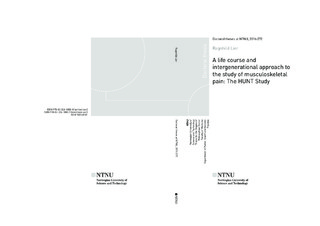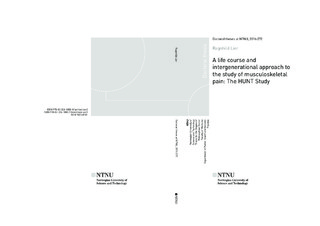| dc.contributor.advisor | Nilsen, Tom Ivar Lund | |
| dc.contributor.advisor | Mork, Jarle | |
| dc.contributor.author | Lier, Ragnhild | |
| dc.date.accessioned | 2016-10-11T11:33:46Z | |
| dc.date.available | 2016-10-11T11:33:46Z | |
| dc.date.issued | 2016 | |
| dc.identifier.isbn | 978-82-326-1883-5 | |
| dc.identifier.issn | 1503-8181 | |
| dc.identifier.uri | http://hdl.handle.net/11250/2414209 | |
| dc.description.abstract | Sammendrag på norsk
Livsløps- og generasjonsstudier av muskel- og skjelettsmerter i HUNT-studien
Kroniske muskel- og skjelettsmerter er blant de fremste årsakene til redusert livskvalitet, sykefravær og uførhet i den vestlige verden. Forekomsten er høy også blant ungdom og unge voksne. I tillegg til den individuelle belastningen, har kroniske muskel- og skjelettsmerter en stor samfunnsøkonomisk betydning relatert til behandling, arbeidsevne og sykefravær. Kunnskap som kan gi mulighet for bedre forebygging og behandling er derfor viktig. Studier har vist at både miljømessige og arvelige faktorer spiller en rolle for utviklingen av kroniske muskel- og skjelettsmerter, og familiestudier har vist en sammenheng i smerte mellom foreldre og deres barn. Det er likevel uklart om denne sammenhengen vedvarer inn i barnas voksenliv.
Ved bruk av data fra Helseundersøkelsen i Nord-Trøndelag (HUNT) koblet til Familieregisteret hos Statistisk Sentralbyrå har vi undersøkt hvorvidt det finnes en sammenheng mellom foreldre og deres voksne barn når det gjelder forekomst av kroniske muskel- og skjelettsmerter. Vi har også studert foreldre-barn sammenhenger i smerte lokaliserte til nakke/øvre rygg og/eller korsrygg for å vurdere om disse assosiasjonene er spesifikke når det gjelder smertelokalisasjon. I tillegg har vi prospektivt undersøkt om barnas risiko for smerte, assosiert med foreldresmerte, kan være modifisert av barnas kroppsmasseindeks og fysiske aktivitet.
Resultatene fra disse familiestudiene viste at kroniske muskel- og skjelettsmerter blant både mødre og fedre er assosiert med høyere forekomst av kroniske muskel- og skjelettsmerter hos deres voksne barn. Assosiasjonene var sterkest når begge foreldrene rapporterer smerte. Vi observerte ingen klar spesifisitet i sammenhengene knyttet til lokalisasjon, men dersom foreldrene hadde smerte både i nakke/øvre rygg og korsrygg var det assosiert med høyere forekomst av smerte blant barna sammenlignet med smerte i bare en lokalisasjon. Resultatene fra den prospektive studien tyder på at normal kroppsvekt reduserte risikoen for å utvikle kroniske muskel- og skjelettsmerter blant barn av foreldre som rapporterte smerte, mens den modifiserende effekten av fysisk aktivitet var mindre klar.
Studiene bidrar til kunnskap om familiære sammenhenger av kroniske muskel- og skjelettsmerter, og at slike sammenhenger er til stede også når barna er voksne. Dette kan være av betydning for valg av forebyggende strategier og terapeutiske tilnærminger for kroniske muskel- og skjelettsmerter. I tillegg tyder resultatene på faktorer som overvekt/fedme og fysisk aktivitet kan påvirke risikoen, særlig i familier som er rammet av kroniske muskel- og skjelettsmerter. | nb_NO |
| dc.description.abstract | English summary
A life course and intergenerational approach to the study of musculoskeletal pain: The HUNT Study
Chronic musculoskeletal pain is among the leading causes of reduced quality of life, sick leave, and disability in Western industrialized countries, with a high prevalence, also among adolescents and young adults. In addition to the individual costs of chronic musculoskeletal pain, there is a substantial economic burden to the society related to treatment, work ability, and sickness absence. Thus, knowledge leading to improved prevention and treatment is important. It has been shown that both environmental and heritable factors have a role in the development of chronic musculoskeletal pain, and family studies have shown associations in pain between parents and children. However, it is not clear if this association persists into the offspring’s adult life.
Based on Data from the HUNT Study, linked with the Family registry at Statistics Norway, we investigated potential associations between parental chronic musculoskeletal pain and occurrence of chronic musculoskeletal pain in their adult offspring. We also investigated parent-offspring associations of pain localized to the neck/upper back and/or low back in order to assess if the specificity of these associations in terms of pain localization. Additionally, we have prospectively examined if the risk of offspring pain associated with parental pain is modified by offspring body mass index and physical activity.
The results from these family-based studies showed that chronic musculoskeletal pain in mothers and fathers was consistently associated with higher occurrence of chronic musculoskeletal pain in the adult offspring, especially if both parents reported pain. We did not observe any clear specificity in the associations regarding pain localizations. However, concurrent neck/upper back and low back pain in parents was more strongly associated with occurrence of pain in the offspring compared to pain in only one of the localizations. The results from the prospective analyses showed that a normal body weight reduced the risk of musculoskeletal pain in offspring of pain-afflicted parents, while a modifying effect by physical activity was less clear.
The results from our studies contribute to the understanding that chronic musculoskeletal pain track across generations, also into offspring’s adulthood. This could be of significance when considering different prevention strategies and therapeutic approaches to chronic musculoskeletal pain. Additionally, the results also indicate that factors like overweight/obesity and physical activity may influence the risk, especially in families with a history of chronic musculoskeletal pain. | nb_NO |
| dc.language.iso | eng | nb_NO |
| dc.publisher | NTNU | nb_NO |
| dc.relation.ispartofseries | Doctoral thesis at NTNU;2016:272 | |
| dc.relation.haspart | Paper 1: Lier, Ragnhild; Nilsen, Tom Ivar Lund; Mork, Paul Jarle. Parental chronic pain in relation to chronic pain in their adult offspring: Family-linkage within the HUNT Study, Norway. BMC Public Health 2014 ;Volum 14.(1). http://doi.org/10.1186/1471-2458-14-797 | |
| dc.relation.haspart | Paper 2: Lier, Ragnhild; Nilsen, Tom Ivar Lund; Vasseljen, Ottar; Mork, Paul Jarle. Neck/upper back and low back pain in parents and their adult offspring: Family linkage data from the Norwegian HUNT Study. European Journal of Pain 2015 ;Volum 19.(6) s. 762-771. Is not included due to copyright, available at http://doi.org/10.1002/ejp.599 | |
| dc.relation.haspart | Paper 3: Lier, Ragnhild; Mork, Paul Jarle; Holtermann, Andreas; Nilsen, Tom Ivar Lund. Familial Risk of Chronic Musculoskeletal Pain and the Importance of Physical Activity and Body Mass Index: Prospective Data from the HUNT Study, Norway. PLoS ONE 2016 ;Volum 11.(4) s. http://doi.org/10.1371/journal.pone.0153828 | |
| dc.title | A life course and intergenerational approach to the study of musculoskeletal pain: The HUNT Study | nb_NO |
| dc.type | Doctoral thesis | nb_NO |
| dc.subject.nsi | VDP::Medical disciplines: 700::Health sciences: 800::Community medicine, Social medicine: 801 | nb_NO |

